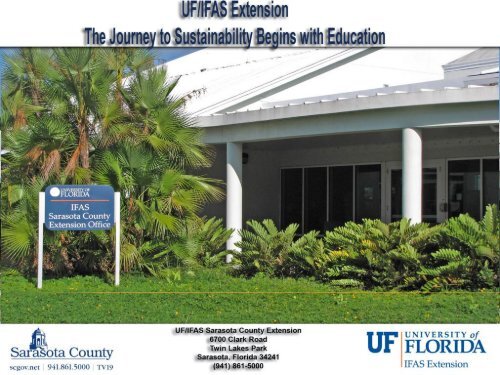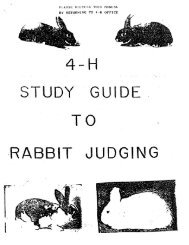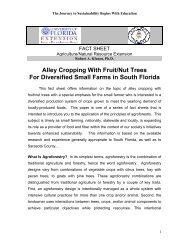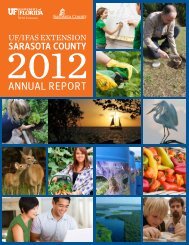Part 2 - Sarasota County Extension - University of Florida
Part 2 - Sarasota County Extension - University of Florida
Part 2 - Sarasota County Extension - University of Florida
- No tags were found...
You also want an ePaper? Increase the reach of your titles
YUMPU automatically turns print PDFs into web optimized ePapers that Google loves.
CHICKENS 101BIOLOGY(ANATOMY, BREEDS,DEVELOPMENT, &REPRODUCTION)
THE BASICS: TERMS1ChickenAnatomy________________________________________________________________3
THE BASICS: TERMS1ChickenWing &FeatherAnatomy________________________________________________________________4
THE BASICS - TERMS1Chick – a new hatch or very youngchickenPullet- a young female chickenHen – a mature female chickenCockerel – a male chicken less than 1year oldCock – a male chicken more than 1year oldRooster- a male chicken________________________________________________________________5
THE BASICS - TERMS1Broiler - used mainly for meat. Abroiler is a chicken is 6 to 7weeks <strong>of</strong> age and weighs 4pounds when it is sent to market.Layer - a mature female chickenthat produces eggs. Most canlay 300 eggs/year.________________________________________________________________6
THE BASICS: BREEDS17
THE BASICS: BREEDSHow Did Chickens Originate?– All breeds are descendents <strong>of</strong> an original Red JungleFowl <strong>of</strong> East Asia. Domestication impacts are great.8
THE BASICS: BREEDS1 There are many things to consider before selecting achicken breed for your flock - whether you are planning tostart a new flock or to add to an existing one. For instance, what are you looking for? a broiler breed a layer breed a dual-purpose breed a pet chickens to show at exhibitions a heritage breed9
THE BASICS: BREEDS1 Before selecting your chickens also reviewyour zoning restrictions For instance . . . is slaughtering allowed ? how many chickens can you have ? are roosters allowed ?10
THE BASICS:BREEDSMany WebsitesAvailable onBreed Traits Infoe.g., the Handy DandyChicken Charthttp://www.ithaca.edu/staff/jhenderson/chooks/chooks.html
THE BASICS: BREED GROUPSMeat Breed Factors1 a fast growing ‘broiler’ breed a Cornish cross can reach 4-5 lbs insix weeks and 6-10 lbs in twelveweeks a slower growing breed (for ‘ethnic markets’) Australorp and Silkie breeds________________________________________________________________12
THE BASICS: BREED GROUPSEgg Breed Factors Hybrids (Production): Not aspecific breed but a cross <strong>of</strong>known breeds. Layers grow slower Flock uniformity More production types Red Sex links Production Reds White Leghorns________________________________________________________________13
Selecting a breed based on egg colorSELECTING A BREED BY EGG COLORWhite EggsLeghornsButtercupAnconaAndalusianHamburgsBrown EggsRhode Island RedRhode Island WhiteBuff OrpingtonPlymouth RocksDelawareDominiqueWyandottesRed Sex Links________________________________________________________________Source:
THE BASICS: BREEDSEgg Breed ExamplesWHITE LEGHORNRHODE ISLAND REDARAUCANAS
THE BASICS: BREEDSHeritage Breeds• Allow you to participate in conservation <strong>of</strong> genetic and breeddiversity• Use breeds that are adapted to area’s environmentalconditions• Opportunities to provide specialty products
THE BASICS: BREEDSHeritage Meat Breed ExamplesNEWHAMPSHIREBARRED ROCKSBUFFORPINGTONS
THE BASICS: DEVELOPMENTSteps in NaturalDevelopment
THE BASICS: REPRODUCTION
THE BASICS: REPRODUCTIONFEMALE POULTRY REPRODUCTIVE SYSTEM‣ The ova produced in the ovary develop into egg yolks.‣ The oviduct <strong>of</strong> the chicken has five parts‣ It takes approximately three hours for the thick whiteto be placed around the yolk in the magnum.‣ It takes approx. 1 ¼ hrs for two shell membranes to beplaced around the yolk and thick white.‣ It takes about 25 to 27 hours for a chicken to produceone egg
THE BASICS: REPRODUCTION
THE BASICS: REPRODUCTIONMALE POULTRY REPRODUCTIVE SYSTEM‣ 1. The vas deferens carries the seminal fluid andsperm cells to the cloaca.‣ 2. The cloaca is the enlarged part where the largeintestine joins the end <strong>of</strong> the alimentary canal.‣ 3. The alimentary canal is the food-carrying passagethat begins at the mouth and ends at the vent.‣ 4. The papilla is the organ in the wall <strong>of</strong> the cloaca thatputs the sperm cells into the hen’s reproductive tract.‣ 5. Roosters are necessary only for fertile eggs
THE BASICS: PRODUCTION DEVELOPMENTIncubatorEggs for Consumptionand/or IncubationBrooderLaying HensHousing & Feeding__________________________________________________________________
THE BASICS: DEVELOPMENTAn Incubator provides and maintains a favorableenvironment for hatching fertile eggs.The incubator replaces the hen.
THE BASICS: DEVELOPMENT4 Important Factors to Successful Incubation Are:1. Temperature – 98 – 102 degrees F2. Ventilation – air must flow through the incubator3. Turning the eggs- at least 3 times daily. Incubatorscan have automatic turners4. Humidity (water)– there must be moisture to keepthe egg shell healthy________________________________________________________________
THE BASICS: DEVELOPMENTChicken Egg Anatomy and Embryo DevelopmentSee video <strong>of</strong> chicken eggdevelopment athttp://www.youtube.com/watch?v=LKvez9duEHQ
THE BASICS: DEVELOPMENTCandling is the process <strong>of</strong> using a bright light to lookinside <strong>of</strong> the egg without cracking it to see if the chick isdeveloping properly.LightNotice the embryo hasbegun to develop.Notice the veins, this isthe embryo forming.
THE BASICS: DEVELOPMENT
THE BASICS: DEVELOPMENTHatching Time Hatching Begins on Day21 give or take 3 days Impacted by Light andTemperature May take Several Hoursfor Chick to Exit Shell Don’t help Chicks Hatch-- Struggle Necessaryfor Survival________________________________________________________________
THE BASICS: DEVELOPMENTAnd Then?• Chicks remain inincubator until dryand fluffy• May take severalhours to dryChicks hatching and dryingin incubator.• Once dry and fluffyplace in brooder
THE BASICS: DEVELOPMENTWhat’s a brooder? Pen for chicks Absorbent bedding i.e. saw dust, newspaper, etc Shop light hung low to warm chicks
THE BASICS: DEVELOPMENTWhy Is Proper Brooder Management So Critical? All <strong>of</strong> the chicken’s body systems are developing Immune system Thermoregulatory system Digestive system Feathering Eating and drinking behavior
BROODER EXAMPLESLamp Type
BROODER EXAMPLESBoxBatteryRing
THE BASICS: DEVELOPMENTBrooder Requirements• Space– Draft shield 12-18” high– ½ square foot <strong>of</strong> space per bird• Heat Sources– light bulb– 95 o F for week 1 – then decrease 5 o F per week.• Litter– 3 inches <strong>of</strong> clean dry litter ( No VERY fine sawdust or cedar )– Keep litter around water and feed dry and cleanHeatSourceWaterSourceFeedSource
THE BASICS: DEVELOPMENTKeep Brooder Clean ! Change out daily‣ Bedding‣ Water‣ Food________________________________________________________________
THE BASICS: DEVELOPMENTBrooder Success Rules <strong>of</strong> Thumb• Water1 quart for every 25 birds (clean and fill daily)For large number automatic watering systems work best• FeedersPlace near heat, but not directly underneath sourceFresh food in front <strong>of</strong> chicks at all times• Delivery DayBrooder up and running 24 hr before chicks arriveHave them sent overnightShow each bird water source________________________________________________________________
BROODERMANAGEMENTTHE CHICKS WILL TELL YOU IF THEY ARE COMFORTABLE
THE BASICS: SEXING YOUNG POULTRY Best way to tell is to wait till they grow upRoosterTail feathersComb sizeWattle sizeHenSpur size
THE BASICS: EGG LAYINGWhy have my hens stopped laying? Nutrition Completely balanced diet Out <strong>of</strong> feed or water Disease Vaccinate (esp. in confinement systems) Age Management Heat Overcrowding Light
THE BASICS: EGG LAYINGWhy have my hens stopped laying?250 eggs per year = 1 st year <strong>of</strong> production
THE BASICS: EGG LAYINGWhy have my hens stopped laying? A layer will produce an egg every 1-2 days Pullets start laying when they reach 20-24 weeks First eggs will be small and on the floor Light hours (have a program) Decrease light hoursfor growing pullets Increase hours afterthey start laying with artificiallights (orange/red lights arebest) to maintain 14-16 hr day length
INFORMATION RESOURCES UF/IFAS <strong>Extension</strong> <strong>Sarasota</strong> <strong>County</strong> Officehttp://sarasota.ifas.ufl.edu/ UF/IFAS Solutions for Your Life - Poultryhttp://solutionsforyourlife.ufl.edu/agriculture/livestock/poultry.html
ONLINE RESOURCES 1 44• American Livestock Breeds Conservancy -http://albc-usa.org/• Backyard Chickens - http://www.backyardchickens.com/• Bio Pod - http://thebiopod.com/index.html• Build A Chicken Coop Easy: How to Build a ChickenCoop - http://www.buildachickencoopeasy.com/• 4 H Virtual Farm – Poultry -http://www.sites.ext.vt.edu/virtualfarm/poultry/poultry.html• Heritage Poultry Conservancy - http://www.heritagepoultry.org/• The City Chicken.com –http://home.centurytel.net/thecitychicken/index.html•
1ACKNOWLEDGEMENTS• Burbaugh, B. Pasture Poultry Systems. UF/IFAS Duval<strong>County</strong> <strong>Extension</strong>.• Butcher, G. 2010. Poultry Disease Prevention and Control forSmall Flock Owners. UF/IFAS.• Chisholm, T., D. Zivnuska, J. Cox, & M. Seipel. Pasturepoultry research, Truman State <strong>University</strong> Ag Science• Clark, F.D. Range Production and Bird Health. <strong>University</strong> <strong>of</strong>Arkansas <strong>Extension</strong> Service• Clifford, J. 2006. Biosecurity Guide for Poultry and BirdOwners. USDA APHIS• Damron, B. & D. Sloan. Small Poultry Flock Nutrition.• Jacob, J. and T. Pescatore. Selecting the right chicken breed.Kentucky Cooperative <strong>Extension</strong> Service.________________________________________________________________45
1ACKNOWLEDGEMENTS• Miles, R. Small scale production and egg production. AnimalScience Department. <strong>University</strong> <strong>of</strong> <strong>Florida</strong>.• Wiggins, L. Chicken Embryology. 4H School EnrichmentProgram. UF/IFAS Taylor <strong>County</strong> <strong>Extension</strong>.• UF/IFAS Alachua <strong>County</strong> <strong>Extension</strong>. Small Scale PoultryProduction.________________________________________________________________46
















